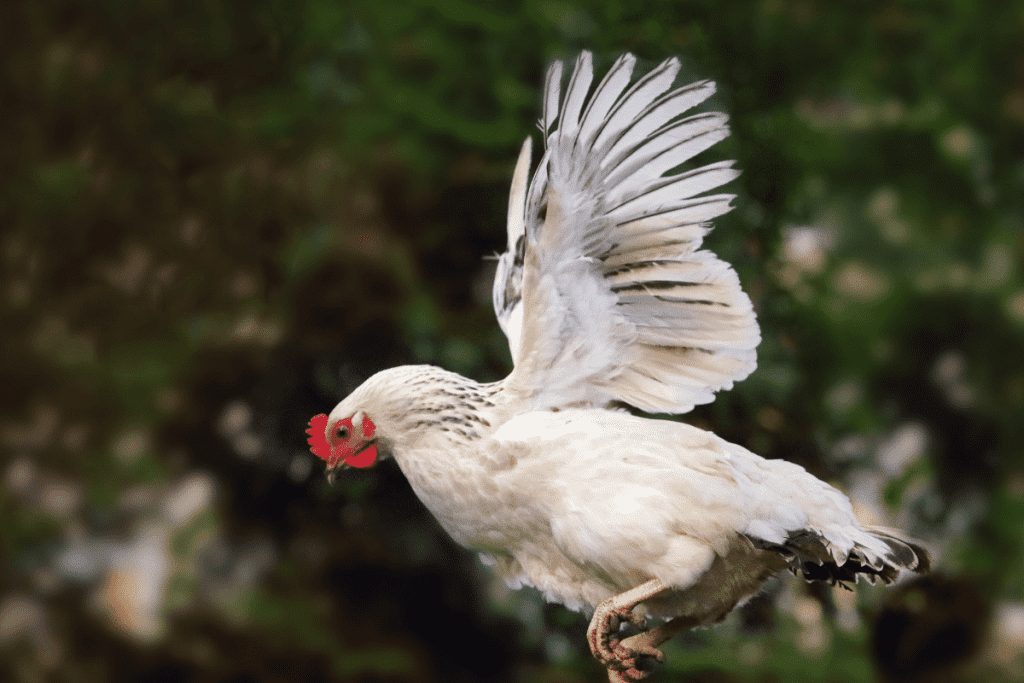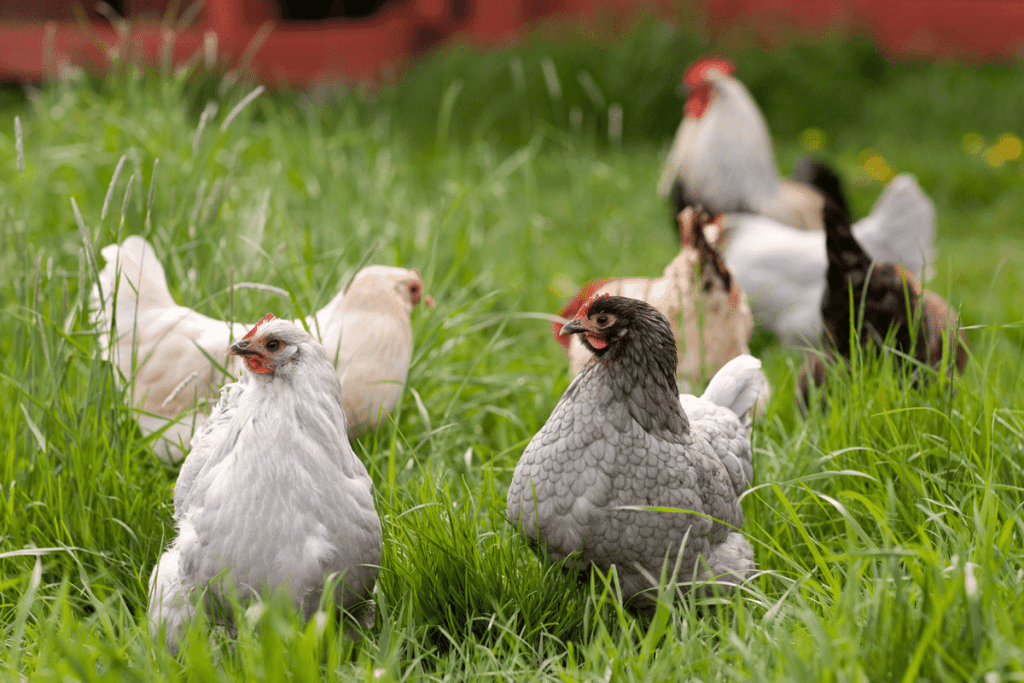Chickens are one of the most widespread animals on the planet!
They outnumber us by almost a 3-to-1 margin, and they’re one of the world’s most common sources of meat.
But what kind of animal even is a chicken, anyway?
Are chickens mammals, birds, reptiles, or even something else entirely?
Chickens are domesticated birds within the Galliformes order, including other heavy-bodied, mostly terrestrial birds like quails, guineafowl, pheasants, and turkeys. More specifically, chickens originated from a few species of wild junglefowl in Southeast Asia.
Keep reading to learn more about these strange animals, what they are and how we classify them scientifically, their traits, where they come from, and what other classes of animals they’re related to.
You’ll be surprised to learn the common chicken has a rich history, even before its domestication thousands of years ago!

Table of Contents
ToggleWhat Kind of Animal is a Chicken?
First things first: chickens are, in fact, birds, even though they don’t look much like the typical songbirds or even birds of prey we’re used to seeing in the wild.
Taxonomically, they’re grouped within the Aves class and all other modern birds, from tiny sparrows to massive ostriches and even the equally unusual penguins.
Think of Aves as the catch-all grouping for all living birds, big and small, flying or flightless.
The main anatomical characteristics of birds within this group include:
- Feathers rather than fur, body hair, or scales
- Toothless beaks, which are specialized for each species’ specific diet and lifestyle
- Four-chambered hearts
- Very lightweight skeletons optimized for fast movement and (sometimes) flight
- Very high metabolisms
- Reproduction via laying of eggs with hard shells, along with a lack of mammary glands (so they don’t produce or feed their babies milk)
- Wings evolved from forelimbs (though a few extinct birds like the moa lacked them!)
Birds also share a few characteristics of mammals, like the ability to generate their internal heat (also known as being endothermic or “warm-blooded”), having vertebrates (backbones), and lungs for breathing air.
Birds are categorized into smaller, more specific groups based on their physical traits, behaviors, diets, and other characteristics.
Chickens belong to the Galliformes order, including other heavy-bodied, mostly terrestrial bird species like turkeys, quails, pheasants, guineafowl, and even the partridge.
Now, getting even more specific regarding the classification of chickens: the domestic chicken’s scientific name is Gallus domesticus.
This name denotes the bird’s genus, Gallus, which includes four junglefowl species native to Southeast Asia.
The red junglefowl, Gallus gallus, is the domesticated chicken’s direct ancestor.
Still, other species like the grey and green junglefowl were likely crossbred to produce different bird lineages.
When Were Chickens Domesticated?
Interestingly, chickens were not originally raised for meat and eggs (or as pets); instead, they were initially domesticated sometime as far back as 8,000 years ago in Southeast Asia for cockfighting for entertainment.
Other groups like the Aryans later also used them in ritual sacrifices to their gods.
Historians believe the birds evolved from a few different species of wild junglefowl in Asia.
These junglefowl had very similar traits to modern-day chickens, though they are more skilled fliers and have a more varied diet.
Over time, the practice of domestication gradually spread from Southeast Asia towards the rest of Asia, the Middle East, and even parts of Europe.
Chickens were likely the first widely domesticated animal in human history, and they remain one of the most widely raised animals in the world.
Grecians and Romans were likely the first to seriously use chickens as a food source, though eating the birds was associated with poverty and the lower social classes in general for quite some time.
When chickens made their way to Egypt, Egyptians learned how to raise chickens from eggs by using artificial incubators.
This was a groundbreaking accomplishment, as it meant people could now get a lot more eggs for consumption out of their chickens while also producing baby chicks in the meantime.
This led to the birds’ further spread and popularity as a food source.
After the Roman empire fell, the domestication of chickens fell out of practice for many years.
They weren’t used as a food source again until around the 1700s.
Later, in the 1800s, chickens became wildly popular once more in Europe and the United States, mostly thanks to a cultural phenomenon known today as “Hen Fever,” which we’ll cover in more detail below.
Thanks to their small size, hardy nature, calm and docile temperaments, ability to produce large amounts of eggs from a young age, and, of course, their tasty meat, chickens have been and still are incredibly useful to us.
They’re commonly kept as pets, as they are highly social and surprisingly intelligent animals.
Check out our complete list of benefits to keeping chickens as pets.
What Was “Hen Fever?”

Oddly enough, the domesticated chicken’s massive resurgence in popularity after the fall of the Roman empire is mostly attributed to Queen Victoria in the 1800s.
The monarch of the Victorian era was gifted a small flock of exotic chickens from China known as Cochins in 1842.
Her flock was a unique one, to be sure, as the exotic Far East birds looked nothing like the chickens the Brits were used to.
She had a special aviary built for the birds, which she was known to dote on like beloved pets.
After successfully breeding some chicks from her flock, the Queen showed them off to her relatives, who also were fascinated by them.
Britain’s royals have long been known as trendsetters, and the case of the domesticated chicken is no exception.
Once the local newspapers heard about Victoria’s unique birds, people throughout the UK obtained and bred their own, leading to a period known today as Hen Fever, which lasted throughout the mid-to-late-1800s.
This trend brought the chicken back to prominence, not only for meat processing and eggs but also as a pet and show animal.
The Hen Fever even spread quickly back across the pond to the United States, and by the late 1800s, people everywhere were developing new and exotic breeds of their own.
Many of today’s more well-known chicken breeds were developed around this same time, such as the Orpington, Houdan, and Plymouth Rock varieties.
Because chickens are so low-maintenance, inexpensive, and hardy, they have remained a useful source of food, entertainment, and even companionship ever since.
Good thing Queen Victoria was so enamored with them!
What Birds Are Chickens Related To?
As we briefly touched on earlier, today’s domesticated chicken’s ancestors are a few junglefowl species, with its primary origin being the red junglefowl, known scientifically as Gallus gallus.
These junglefowl are native to Southeast Asia and very closely resemble Gallus domesticus or today’s domesticated chicken as we know it.
In 2004, the National Human Genome Research Institute completed its first build of the chicken genome sequence project, which soon unearthed a massive wealth of information on the bird’s genetic roots and history, as well as the histories of many related species.
Notably, this makes the chicken the first agricultural animal in history to have its genome fully sequenced.
While Charles Darwin suggested many years before the red junglefowl was the chicken’s closest ancestor, the genome sequencing project confirmed this theory by providing the means to closely examine the birds’ mitochondrial DNA.
The chicken sequence of DNA has also been very useful for biomedical research, especially in creating vaccines and treating viruses.
Aside from the Asian junglefowl, chickens are also related to many other birds within the Galliformes order, including other heavy-bodied, ground-dwelling species like turkeys, quail, pheasants, peafowl, and more.
These species are sometimes referred to as Gallinaceous birds.
Most of these related species are, like the chicken, entirely or mostly flightless birds with short wings and stocky, large round bodies.
They mostly get around by running rather than flying, though many species can glide short distances.
The birds’ large bodies and heavy plumage make them withstand cold winters quite well, meaning they are highly adaptable and don’t necessarily have to migrate when temperatures drop.
Did Chickens Come From Dinosaurs?
You’ve likely heard someone claim chickens are direct descendants of dinosaurs (or, perhaps, dinosaurs are chickens’ common ancestor) at some point and wondered how much truth there is to such a statement.
Wouldn’t reptiles be more closely related to dinosaurs, just based on appearance?
Well, not exactly.
It turns out chickens (along with a few other Galliformes, like turkeys) are the closest living relatives to two-legged dinosaurs within the Theropoda clade, better known as theropods.
This group includes the most notorious ancestor of birds, the Tyrannosaurus Rex, among others like Velociraptors.
If you look at a typical theropod’s assumed body shape, it’s easy to see how their tiny forelimbs eventually evolved into more specialized wings as more and more bird clades rose to prominence.
Right after the dinosaurs went extinct around 65 million years ago at the end of the Cretaceous period, birds went through a sort of evolutionary explosion of bird speciation where various species branched off from one another and developed new traits and further new species and so on.
Researchers in 2008 found the chicken lineage has remained the most similar to dinosaurs over the years.
By comparing molecules of a fossilized Tyrannosaurus Rex’s collagen to those of more than 20 different kinds of animals, they found chickens were the closest match, with alligators being the second closest.
This means chickens are more closely related to dinos than stereotypically “dinosaur-looking” cold-blooded animals like lizards, crocodiles, or snakes!
How useful was this post?
Click on a star to rate it!
We are sorry that this post was not useful for you!
Let us improve this post!
Tell us how we can improve this post?
